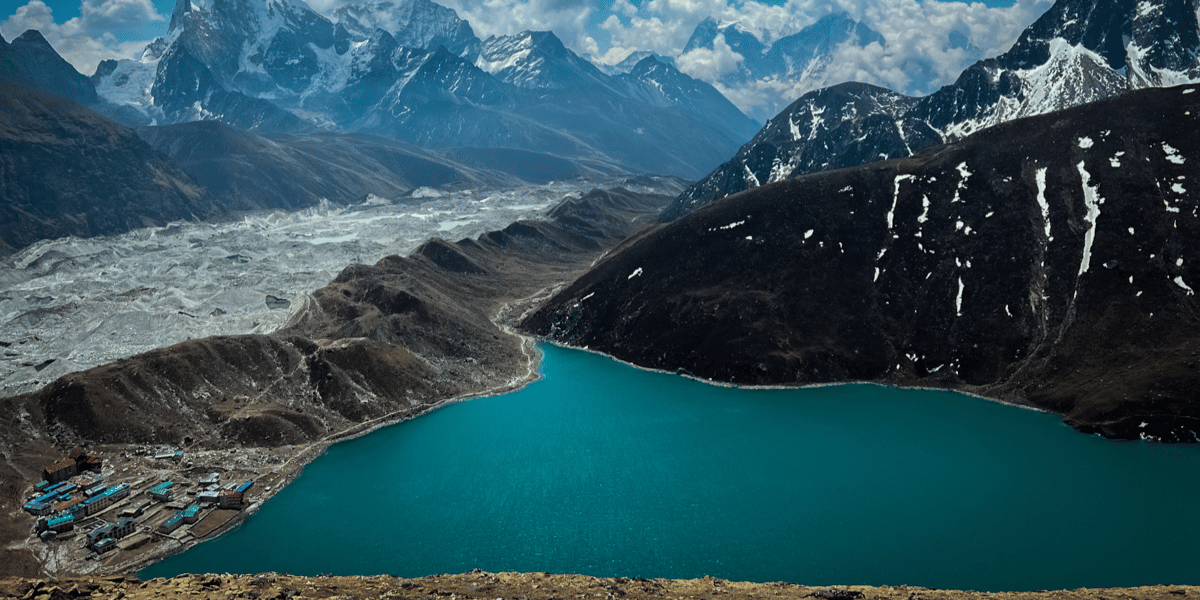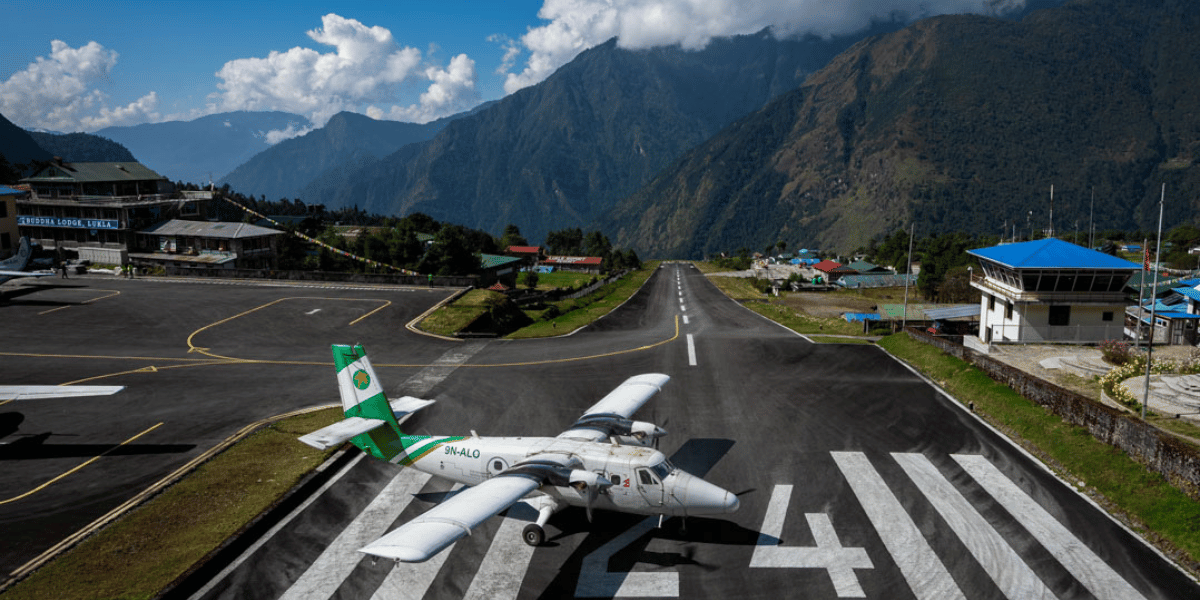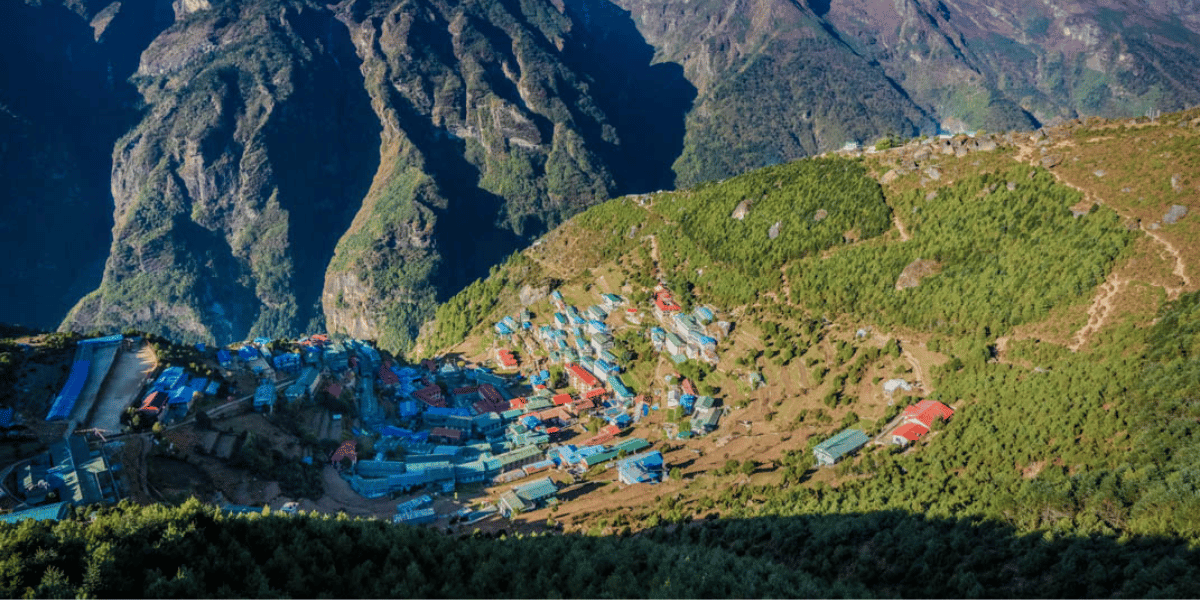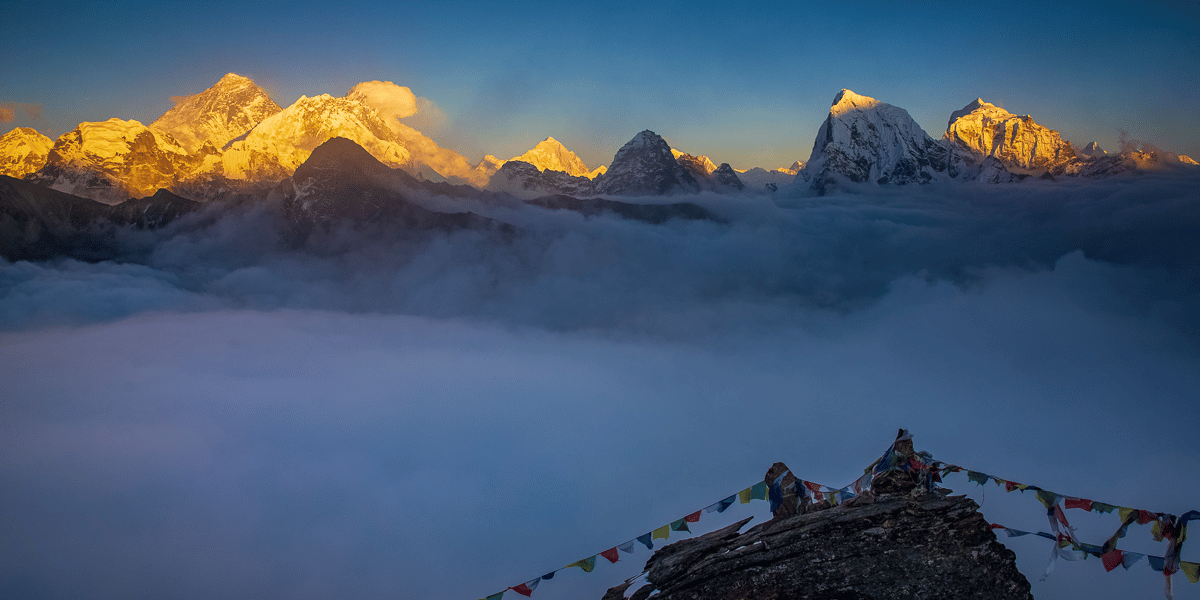The Gokyo Lakes Trek is considered one of the top treks in the Everest Region, following the Everest Base Camp trek. Travel on a journey to discover the stunning lakes of the Everest region, surrounded by breathtaking landscapes and picturesque trekking routes. This 14-day trek will take you to some of the most beautiful locations in the Everest Region. Exploring the Everest region means venturing into the Sagarmatha National Park, one of Nepal's 12 national parks. The landscape is vast and diverse, showcasing some of the most phenomenal natural beauties, from the world's tallest mountain, Everest, to stunning lakes and high trekking passes that you will explore during the trek. During the trek, you will come close to the stunning Gokyo Lakes, an oligotrophic lake nestled in a unique location that looks surreal. Set off on this trek to discover a hidden gem and experience the extensive natural beauty and stunning mountains up close.
During this trek, you will discover some of the most stunning lakes in the Everest region of Nepal, surrounded by breathtaking landscapes and picturesque trekking routes. Before beginning your trek, you will spend a few days in Kathmandu, exploring its rich historical sites. The city is adorned with numerous ancient landmarks that hold great religious and cultural importance. During the trek, you will encounter various cultures, landscapes, historical sites, stunning mountain views, challenging high trekking passes, and more. Below are some of the major highlights of this trip.
Kathmandu- The Capital City
During your stay in Kathmandu, you will explore and soak in as much beauty as possible, as it is the starting point of your trip. Kathmandu is known by various names given by its travellers, with one of the most popular being 'The City of Temples' due to the numerous religious landmarks scattered throughout the city. There is reportedly a temple every kilometre. You will explore the stunning landmarks during your sightseeing programme and get a glimpse of the country's history, magnificent art, and beauty firsthand. The following places are all UNESCO World Heritage Sites. You will visit them one by one, starting with the most popular one, Kathmandu Durbar Square. This former palace in Nepal is situated in the heart of Kathmandu, among many others. This square contains a cluster of ancient landmarks, including glorious temples, courtyards, majestic sculptures, and architecture showcasing Nepal's authentic art. Another beautiful landmark is Swayambhunath Stupa, also known as the ‘Monkey Temple’. It is situated on a small hillock inside the Kathmandu valley, overlooking the city and providing a panoramic view of the city. This site is dedicated to both Hindu and Buddhist religions, showcasing religious harmony. Up next is the highly respected Hindu temple, Pashupatinath Temple, dedicated to the Hindu deity Shiva. The pilgrimage site was constructed around 400 AD, making it one of the oldest sites. It represents beautiful architectural designs from the Malla Era, featuring pagoda-style monuments that capture people's attention with their unique and ancient designs. Last but not least, the Boudhanath Stupa is dedicated to the Buddhist religion and is one of the biggest stupas in the world. It is a spiritual hub for many, projecting spiritual tranquility and featuring amazing architectural designs that leave people mesmerised. The monument is decorated with vibrant prayer flags that are believed to bring peace worldwide.
Once you've taken in the rustic charm of the city, join us on a trekking adventure to Sagarmatha National Park to discover its wild beauty and majestic mountains. The Everest region is expansive, with numerous opportunities for exploration and discovery. Here are some highlights you may encounter during your trek:
Lukla - The Gateway to Everest Region
Lukla serves as the main starting point for treks in the Everest region, connecting it with other parts of the country. Situated at an elevation of 2,840 m above sea level, this location provides jaw-dropping views of the surrounding area and is close to the mountains. Lukla is a popular spot in the Everest region because of its picturesque airport, which is renowned for its distinctive setting. Lukla is where you'll find an airport called Tenzing Hillary Airport, which boasts one of the shortest runways in the world. Accessing this location via a domestic flight from Kathmandu is an exhilarating and captivating experience that is sure to get your heart racing.
Namche Bazaar -The Sherpa Hub
Namche Bazaar is a historical trading route that showcases the rich culture and history of the Sherpas, attracting many trekkers to visit. Located at an elevation of 3,440 m above sea level, this stop is a favourite among trekkers seeking to acclimatise and take in the stunning natural beauty. The Everest region has numerous iconic places, with Namche standing out for its celestial location and amazing facilities that are hard to find elsewhere. In addition to its seclusion, visitors can find a variety of amenities, ranging from ATMs to fantastic coffee shops and game bars, making this place a top destination in the region.
Gokyo Lakes
The Gokyo lakes in Nepal are oligotrophic lakes located in Sagarmatha National Park at an elevation of 4,700 to 5,000 m above sea level. The lake and its surroundings are named after a nearby peak known as Gokyo Ri. The Goyo Lakes are situated in the Khumjung Village Development Committee of Solukhumbu district in the Sagarmatha Zone in northeastern Nepal. The Gokyo lakes system consists of 19 lakes spread over an area of 196.2 hectares, ranging from 4600m/15,100 ft to 5,100m/16,700 ft. Gokyo Cho, also known as Dhud Kunda, is one of the most stunning lakes in the region, situated next to the colossal Ngozumpa, the longest glacier in Nepal.
Gokyo Ri
Gokyo Ri is a small peak situated at an altitude of 5,357 m above sea level. It is a beautiful summit that offers a splendid view of at least four 8,000m mountains, including Mt. Everest, Makalu, Lhotse, and Cho Oyu. There are smaller mountains below 7,000m that can be seen from this viewpoint. Gokyo Ri offers a stunning panoramic view of the lakes, glaciers, and mountains in the Everest region. From the top of Gokyo Ri, you can see Gokyo Lakes 4 and 5. Additionally, the most stunning perspective of Everest is visible from the summit of Gokyo Ri. Exploring the wide range of Himalayan panoramas from the top of Gokyo Ri is truly fascinating. The Ramsar area of Gokyo offers a breathtaking view from Gokyo Ri. Experience a breathtaking view of endless mountain ranges, including the majestic Mt. Everest. Discover the stunning landscapes of the Gokyo region.
Renjo La Pass
During the trek, you will encounter several stunning places and locations. One of the most challenging trekking passes is the Renjo La Pass, situated at an elevation of 5,340 metres above sea level. It is also one of the most challenging passes in the Everest region, which lies north of Namche Bazaar. Besides that, you can also witness the marvellous views of the high mountain ranges and the deep valleys from the top of the pass. From the top of the pass, you'll be able to enjoy breathtaking views of the high mountain ranges and deep valleys. After crossing the Renjo La Pass from Gokyo Lakes, you'll find Lunde village. Exciting alpine glacial views and snowy trails make this pass a thrilling experience. Renjo La Pass stands out as one of the three main passes in the Everest region. The scenarios, landscape, and sherpa culture make any challenges during the trek worthwhile. The path to Renjo La Pass is quieter compared to other trekking routes in the Everest Region.
What to expect?
The Gokyo Lakes Trek is highly sought after in the Everest region and is one of the most popular treks after the Everest Base Camp trek. Throughout the trip, you will get to see and explore the hidden gems of Nepal and its stunning beauties up close. During the trip, you will have the opportunity to spend some time in Kathmandu, a fantastic place to kick off your journey. Here, you can enjoy sightseeing and prepare for your trek, whether it's shopping for gear or getting ready for the adventure. Here, you will explore the historical sites and gain insight into Nepal's glorious history and beauty. You will begin your trek with an exciting flight to Lukla, which serves as the starting point of the trek and the gateway to the Everest Region. You will start your trekking journey towards the iconic lake, passing through wonderful villages and stops full of culture and stunning beauty. As you trek, you will pass through stunning villages like Namche and Machhermo, both picturesque and highlights of the journey. The places highlight the Sherpa culture and people who have had a significant impact on the mountaineering industry with their skills and bravery. During the trek, you will be amazed by the stunning views of the mountains and the diverse landscape, transitioning from lush alpine forests to rocky, cold terrain surrounded by towering mountains.
After visiting these iconic locations, you will head towards the beautiful Gokyo Lakes. You will walk through a scenic and cold region surrounded by mountains and reach Gokyo, where you will get a mesmerising view of the turquoise lake surrounded by the mountains. You will stay overnight besides the lake at the local lodge and tea houses with a jaw-dropping view. Take a day to explore the area and its beauty. Enjoy the celestial view from Gokyo Ri, with a panoramic view of the mountains, lake, and the longest glacier, Ngozumpa. Once you've finished exploring Gokyo, you'll head towards Namche by crossing the challenging Renjo La Pass, standing at an elevation of 5,340 metres. Once you cross the pass, you will hike back to Lukla and end your journey by flying to Kathmandu. Upon arriving in Kathmandu, you can enjoy a leisurely day to unwind from your trek and discover the bustling streets of the city.
Prepare to be physically challenged as you navigate high-altitude terrain, with altitudes ranging from 2,000m to 5,000m above sea level. Setting out on this adventure necessitates prior trekking experience and a strong level of fitness. Throughout the trek, you will be hiking at high altitudes for approximately 4-6 hours daily, presenting some challenges. In addition, you will need to cross the high trekking pass known as Renjo La Pass, which is located at an elevation of over 5000m. This trek presents a challenge because of the potential for high-altitude sickness, which should not be taken lightly. Being physically and mentally prepared will help you tackle the challenge of this trek and enjoy the best trekking experience. You'll get to witness majestic mountains up close and explore unique terrain while immersing yourself in a fascinating culture. Despite the challenges, a professional trekking guide will accompany you throughout the trek to provide essential information for your safety and enhance your overall experience.
Our Gokyo Lakes Trek stands out as one of the top treks in the Everest region due to its customisable itinerary and unique trekking experience. This trek offers a unique travel experience by taking you to a hidden gem in the region, a truly surreal location. You will be captivated by the beauty of nature and its wonders up close, face to face, throughout the trek. During the trip, you will have the opportunity to discover the cultural beauty and stunning natural landscapes that will leave you in awe. Discover vibrant culture and breathtaking natural wonders, waiting to be explored and admired for their untamed beauty. Join us on a trek to the jaw-dropping lake nestled between mountains that offers a close-up view of the lofty mountains.
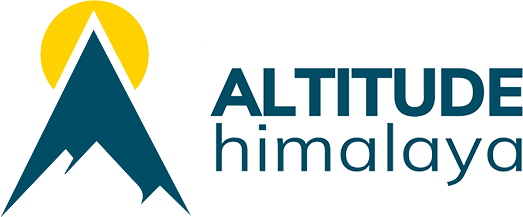

 Adventure
Adventure
 Couple
Couple
 Family
Family
 Luxury
Luxury
 Motorbike
Motorbike
 Photography
Photography
 Wildlife
Wildlife
 Yoga
Yoga
 Annapurna
Annapurna
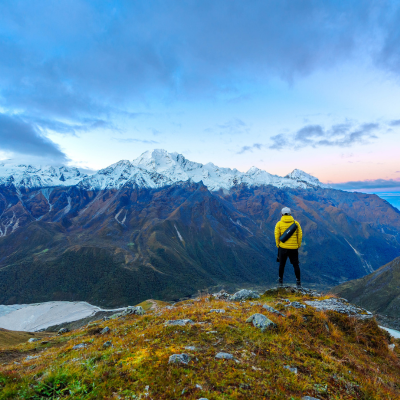 Langtang
Langtang
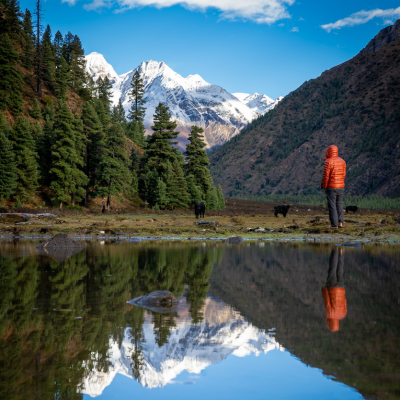 Dolpo
Dolpo
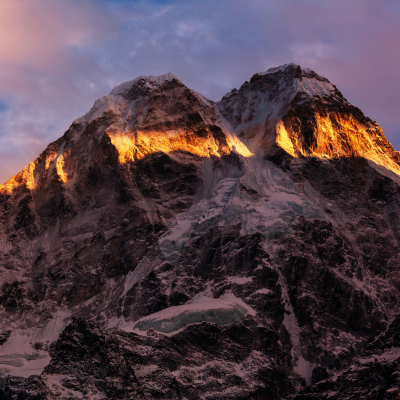 Eastern Nepal
Eastern Nepal
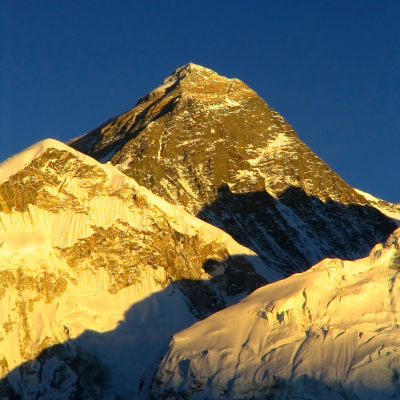 Everest
Everest
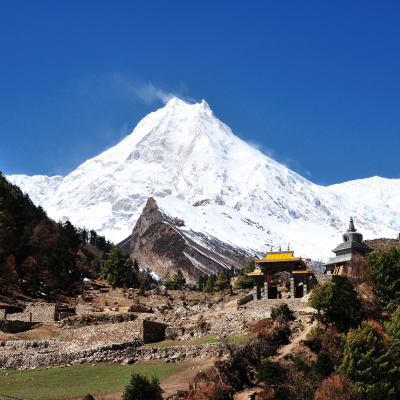 Manaslu
Manaslu
 Western Nepal
Western Nepal
